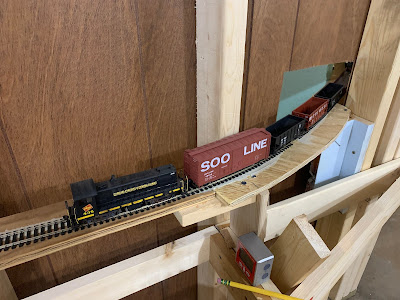Made more progress this weekend than I expected. We’ve been having a yard sale on Friday and Saturday, so that cut into my weekend morning routine of early layout work before everyone else gets out of bed.
First thing accomplished was the installation of a switch and all the track for the chemical plant. This is the first industry “north” of staging before you get to the rolling mill and electric furnace on the opposite side of the peninsula.
Finally, I turned an idea into reality. On previous layouts, I borrowed a friend’s method of mounting ground throws at the front edge of the layout. I wanted to go a step further and mount the ground throws to the fascia. I found wooden oval plaques (3”x 5”) at the craft store and cut them in half lengthwise and drilled two holes so they could be mounted to the fascia. Here is how it turned out. Should work well. They’ll protect the ground throws from getting bumped into, but won’t inflict pain on operaters who might bump into them.





















